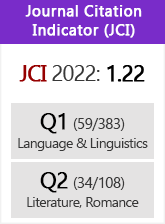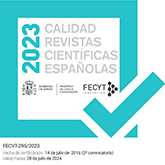Problematic mutations in Calila e Dimna: an analysis in the light of the Arabic versions
DOI:
https://doi.org/10.3989/rfe.2024.1337Keywords:
Calila e Dimna, Kalila wa-Dimna, Mutations, Exemplary Literature, Cultural TranslationAbstract
In the present work, four representations of mutations in Calila e Dimna will be analyzed and compared, when necessary, with three versions of the Arabic Kalila wa-Dimna and two Sanskrit sources, Panchatantra and Mahābhārata. This comparison has a dual objective: on the one hand, with regard to the relationship between the Castilian Calila and the Arabic Kalila, it is intended to confirm the closeness between both branches of this story; on the other hand, consulting different versions of the same story serves to shed light on complex or problematic aspects of the narration, such as representations of transformations or conversions. This analysis will be framed by the concept of cultural translation.
Downloads
References
l-Muqaffa, Ibn (1957): Kalila wa Dimna, ed. Louis Cheikho, Beirut, Matba’a al-Katulikiyya.
Al-Muqaffa, Ibn (1980): Kalila Wa Dimna, ed. ʿAbd-al-Wahhāb ʿAzzām, El Cairo, Dar Al-Maaref. (En notas, Az.)
Alemany y Bolufer, José (1915): La antigua versión castellana del Calila y Dimna cotejada con el original árabe de la misma, Madrid, Librería de los Suc. de Hernando.
Bravo, Federico (2000): “Arte de enseñar, arte de contar: en torno al exemplum medieval”, en La enseñanza en la Edad Media: X Semana de Estudios Medievales, Nájera 1999, eds. José Ignacio de la Iglesia Duarte, Logroño, Instituto de Estudios Riojanos, pp. 303-328.
Brockington, John (1998): The Sanskrit Epics, Leiden, Brill.
Carbonell i Cortés, Ovidi (1997): Traducir al otro: traducción, exotismo, poscolonialismo, Cuenca, Ediciones de Universidad de Castilla-La Mancha.
Cirlot, Juan Eduardo (2018): Diccionario de símbolos, Madrid, Siruela.
Covarrubias, Sebastián de (1993): Tesoro de la lengua castellana o española, ed. Martín de Riquer, Barcelona, Altafulla.
De Blois, François (1990): Burzoy´s Voyage to India and the Origin of the Book of Kalilah wa Dimnah, Londres, Royal Asiatic Society.
Döhla, Hans (2009): El libro de Calila e Dimna (1251): edición nueva de los dos manuscritos castellanos, con una introducción intercultural y un análisis lexicográfico árabe-español, Zurich, University of Zurich, Faculty of Arts.
Edgerton, Franklin (1924): The Panchatantra Reconstructed (Vol. 1-3), New Haven, American Oriental Society.
Fitzgerald, James L. (ed.) (2004): The Mahābhārata. Book 11: The Book of the Women. Book 12: The Book of Peace, Vol. 7, Chicago-London, University of Chicago Press.
Gabrieli, Francesco (1932): “L’Opera di Ibn al-Muqaffa”, Rivista degli studi orientali, 13 (3), pp. 197-247.
Geib, Ruprecht (1969): Zur Frage nach der Urfassung des Pañcatantra, Wiesbaden, O. Harrasowitz.
Gruendler, Beatrice (2013): “Les versions arabes de Kalila wa-Dimna: Une transmission et une circulation mouvantes”, en Marie-Sol Ortola (ed.), Énoncés sapientiels et littérature exemplaire: Une intertextualité complexe, Nancy, Éditions Universitaires de Lorraine, pp. 387-418.
Gupta, Swarajya Prakash y K. S. Ramachandran (eds.) (1976): Mahābhārata: Myth and Reality. Differing Views, New Delhi, Agam Prakashan.
Haro Cortés, Marta (1995): Los compendios de castigos del siglo XIII: técnicas narrativas y contenido ético, Valencia, Departamento de Filología Española Universitat de València.
Haro Cortés, Marta (1996): La imagen del poder real a través de los compendios de castigos castellanos del siglo XIII, Papers of the Medieval Hispanic Research Seminar 4, London, Department of Hispanic Studies, Queen Mary and Westfield College, University of London.
Hertel, Johannes (1909): Tantrākyāyika, die ältere Fassung des Pañcatantra, 2 tomos, Leipzig/Berlin, Weidmannsche Buchhandlung.
Hertel, Johannes (1914): Das Pañcatantra : seine Geschichte und seine Verbreitung, Leipzig/Berlin, Teubner.
Hiltebeitel, Alf (2001): Rethinking the Mahābhārata: A Reader’s Guide to the Education of the Dharma King, Chicago, University of Chicago Press.
Hiltebeitel, Alf (2005): “On Reading Fitgerald´s Vyasa”, Journal of the American Oriental Society, 125 (2), pp. 241-261.
Lacarra, María Jesús (1999): Cuento y novela corta en España: Edad Media, Barcelona, Editorial Crítica.
Lacarra, María Jesús (2002). “Calila e Dimna”, en Carlos Alvar y José Manuel Lucía Megías (eds.), Diccionario Filológico de Literatura Medieval Española. Textos y Transmisión, Madrid, Castalia, pp. 231-235.
Lacarra, María Jesús (2018): “Ratas, niños y ratones en el Calila e Dimna”, en Hugo Bizzarri (ed.), Monde animal et végetal dans le récit bref du Moyen Âge, Wiesdaben, Reichert Verlag, pp. 55-68.
Lacarra, María Jesús y Juan Manuel Cacho Blecua (eds.) (1984): Calila e Dimna, Madrid, Castalia.
Mazid, Baha al-Din (2009): “Date-palms, language and the power of knowledge: An analysis of a fable from Kalila and Dimna”, Journal of Pragmatics, 41, pp. 2515-2534.
Nöldeke, Theodor (1905): “Zu Kalila wa-Dimna”, Zeitschrift der deutschen morgenlaendischen, LIX, pp. 794-806.
Nöldeke, Theodor (1912), Burzöes Einleitung zu dem Buche Kalila waDimna, Strassburg, Karl J. Trübner.
O’Kane, Eleanor (1959): Refranes y frases proverbiales españolas de la Edad Media, Madrid, Boletín de la Real Academia Española, anejo II.
Olivelle, Patrick (1997): Pancatantra. The Book of India´s Folk Wisdom, Oxford, Oxford University Press.
Rodríguez Adrados, Francisco (1999): History of the graeco-latin fable. Volume I. Introduction and from the Origins to the Hellenistic Age, Vol. 1, Leiden/Boston/Köln, Brill.
Rubio Tovar, Joaquín (2013): Literatura, historia y traducción, Madrid, Ediciones La Discreta.
Sarmiento, Martín (1775): Memorias para la historia de la poesía y poetas españoles. Dadas a luz por el monasterio de S. Martín de Madrid y dedicadas al Excmo. Sr. Duque de Medina-Sidonia, Madrid, Joachim Ibarra.
Sprengling, Martin (1924): “Kalila Studies I”, The American Journal of Semitic Languages and Literatures, 40 (2), pp. 81-97.
Sullivan, Bruce M. (1990): Kṛṣṇa Ḍvaipāyana Vyāsa and the Mahābhārata: A New Interpretation, Leiden/New York/Kobenhavn/Köln, Brill.
Thomas, Lynn (2008): “Mahābhārata”, en Denise Cush, Catherine Robinson y Michael York (eds)., Encyclopedia of Hinduism, London/New York, Routledge, pp. 469-471.
Van Ruymbeke, Christine (2016): Kashefi’s Anvar-e Sohayli: Rewriting Kalila Wa-dimna in Timurid Herat, Leiden/Boston, Brill.
Van Scoy, Herbert Allen (1986): A Dictionary of Old Spanish Terms Defined in the Works of Alfonso X, Madison, The Hispanic Seminary of Medieval Studies.
Wacks, David (2007): “The Cultural Context of the Translation of Calila e Dimna”, en Framing Iberia. Maqamat and Frametale Narratives in Medieval Spain, Leiden, Brill, pp. 86-128.
Published
How to Cite
Issue
Section
License
Copyright (c) 2024 Consejo Superior de Investigaciones Científicas (CSIC)

This work is licensed under a Creative Commons Attribution 4.0 International License.
© CSIC. Manuscripts published in both the printed and online versions of this Journal are the property of Consejo Superior de Investigaciones Científicas, and quoting this source is a requirement for any partial or full reproduction.All contents of this electronic edition, except where otherwise noted, are distributed under a “Creative Commons Attribution 4.0 International” (CC BY 4.0) License. You may read here the basic information and the legal text of the license. The indication of the CC BY 4.0 License must be expressly stated in this way when necessary.
Self-archiving in repositories, personal webpages or similar, of any version other than the published by the Editor, is not allowed.














